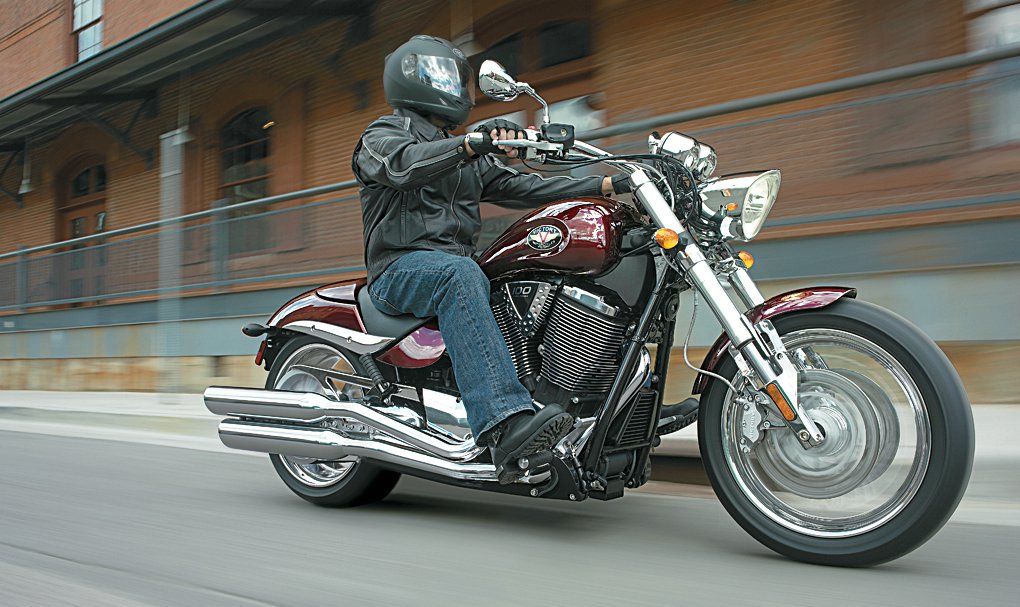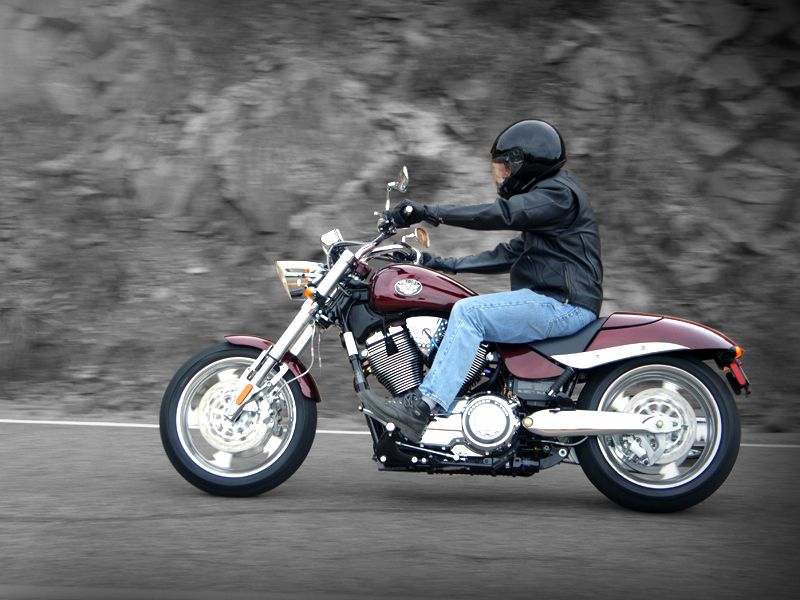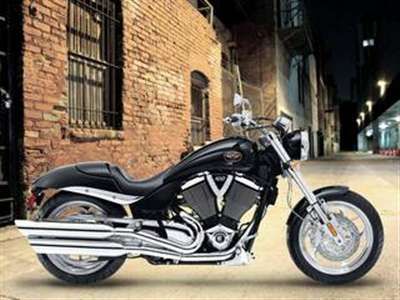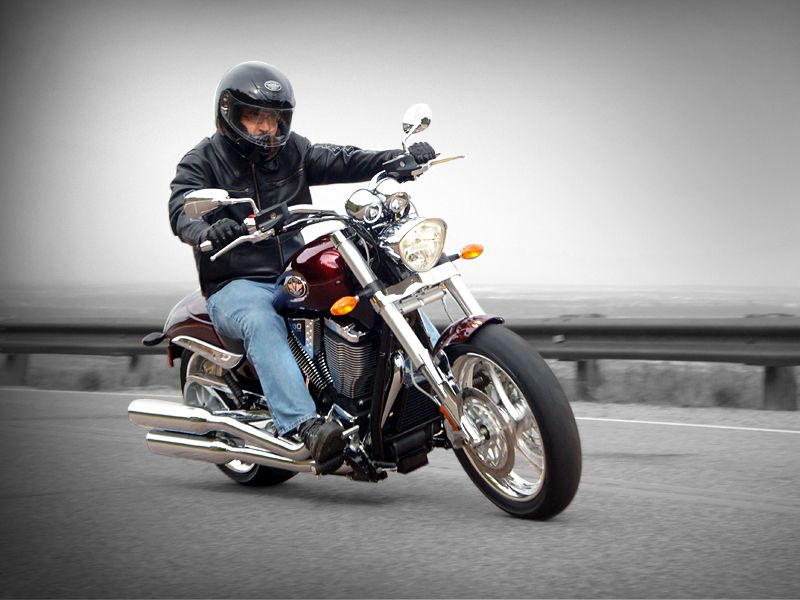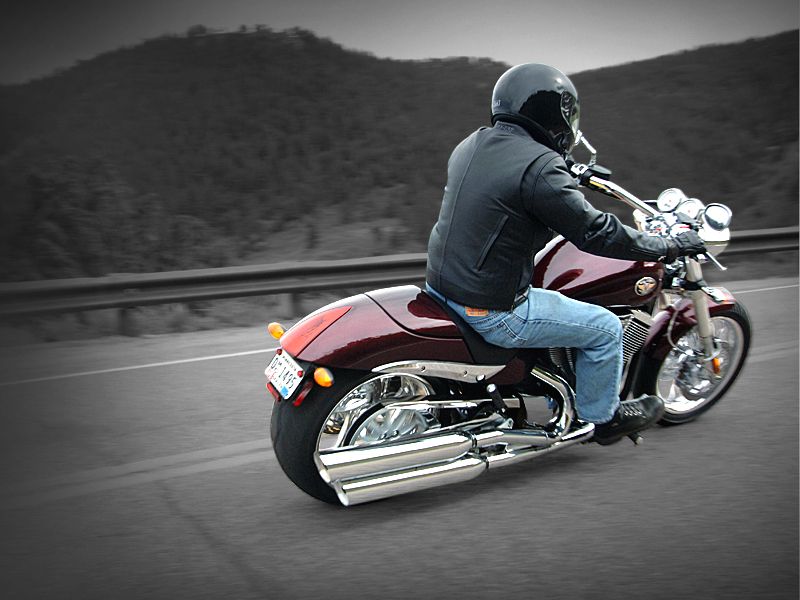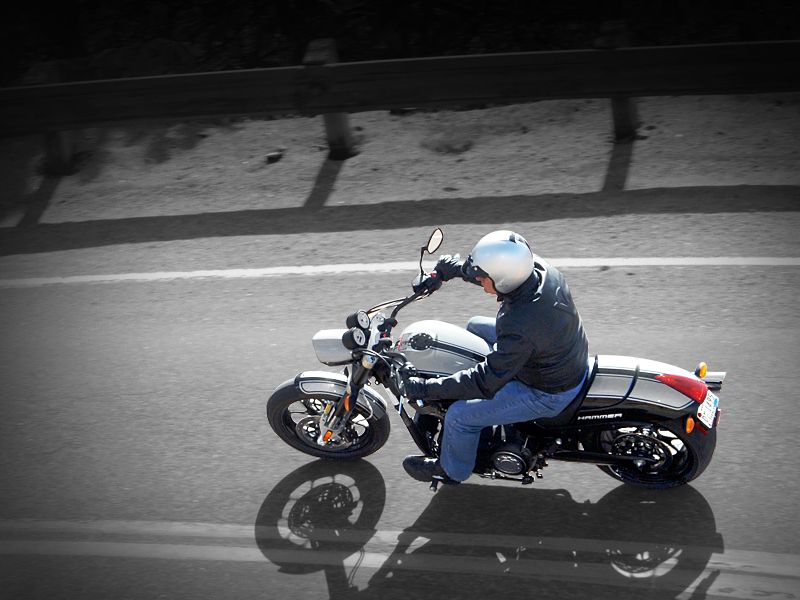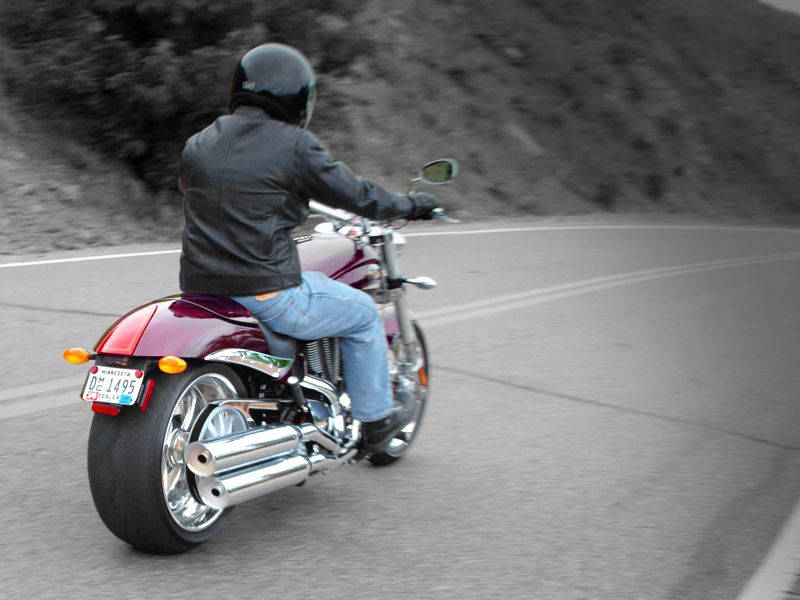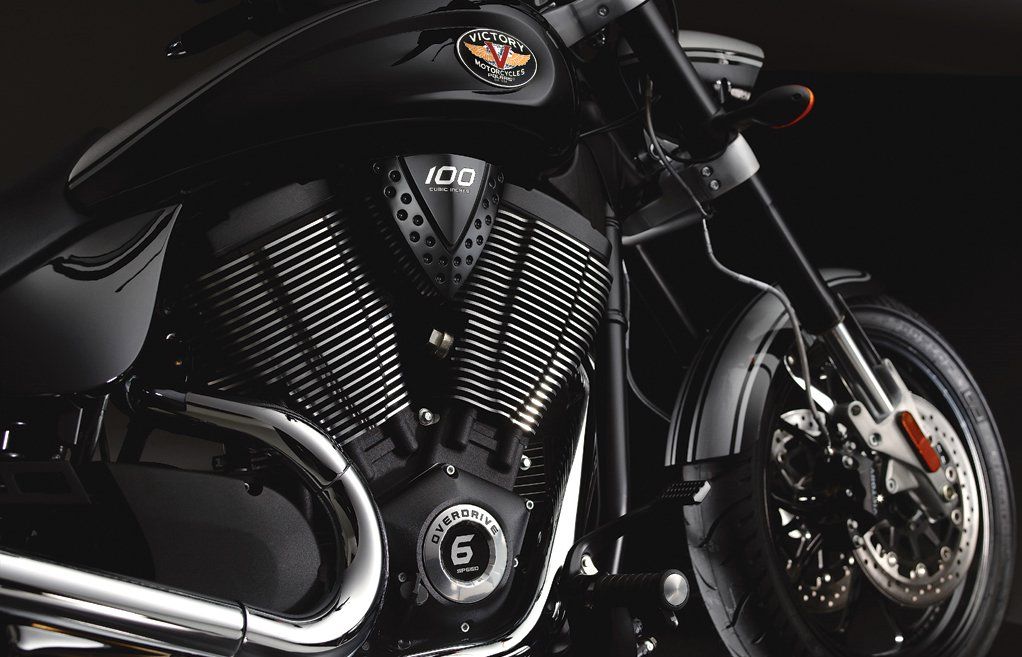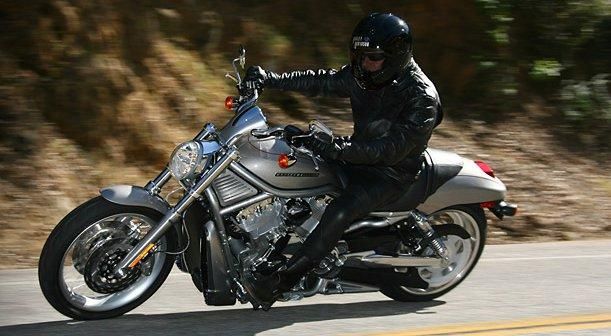By introducing the 2008 Hammer and Hammer S Victory clearly intends to define the American muscle cruiser class and impose these two models as leaders. There is simply nothing to compare with the stout, muscular frame, beefy 250mm rear-tire and aggressive lines so the success is practically guaranteed.
2008 Victory Hammer
- Make: Array
- Model: 2008 Victory Hammer
- Engine/Motor: 4-stroke 50° V-Twin
- Horsepower: 85 HP
- Transmission: 6-speed overdrive constant mesh
- [do not use] Vehicle Model: Array
Introduction
But as the first impression fades away, features such as the inverted front fork, dual disk brakes, performance V-twin engine and comfortable seating position will further contribute to the immediate great opinion that you’ll form about it.
A great torque and horsepower provider, the engine will get close to a rider’s heart with a simple twist of the throttle.
History
You will find that the first model of Victory Hammer, which was introduced in 2005, isn’t that different from what you’re buying today but the magic consists in details so that’s what we’ll be studying.
The all-new American brute muscle and radical custom style bike entered the scene featuring the same 100 cubic inches V-twin engine fed through an Electronic Fuel Injection system featuring 44mm throttle bodies. Oil and air cooling, six-speed gearbox and belt final drive, it was all there.
Colors available in 2005 were Black, Indy Red, Cosmic Sunburst, Flame Yellow (Solid Colors) and Indy Red with Tribal Tattoo, Toxic Green with Tribal Tattoo (Multiple colors).
What came new on the bike for 2006 was the massive 250mm rear tire especially designed by Dunlop which also required a widened rear fender on top of it. Also brand new was the bar’s V configuration, the deep saddle, and the custom inspired paintjob which made it stand out even more.
In 2007 the Victory showed its even sportier face with the all-new Hammer S. What sets the bike apart from the normal version (unchanged in 2007) is the blacked-out engine, handlebars, gauges, virtually anything that would have been chromed on the simple Hammer. Performance Machine supplied with a pair of red, powder-coated Gatlin wheels which together with the custom-looking bike created an easily standing out product.
Competition
Harley-Davidson couldn’t have missed this party so it created the V-Rod and the Night-Rod special. Both of these bikes look like taken right off the drag circuit as they are low and sleek. And this Harley has an engine that backs its looks up: 123hp, 1250cc liquid-cooled (the first street-legal Harley to feature liquid cooling) Revolution engine. The rear tire is 240mm wide, almost as beefy as Hammer’s but the low general appearance makes the rear tire look actually wider.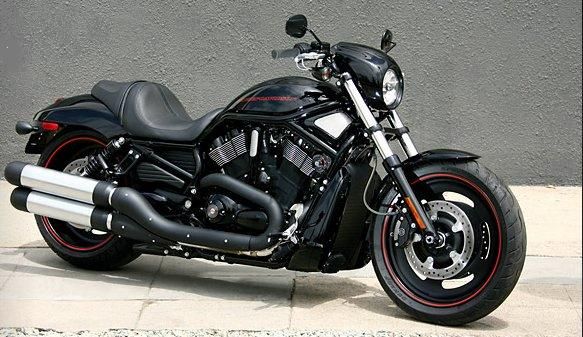 The Night-Rod Special clearly stands out thanks to its looks as it features black everything: exterior, engine, exhaust pipes, headlight cover, handlebars and mirrors, rims (with orange pinstripes). Mechanical features are the same as on the V-Rod so Harley and Victory both use the same recipe when intending to make a bike easily distinguishable.
The Night-Rod Special clearly stands out thanks to its looks as it features black everything: exterior, engine, exhaust pipes, headlight cover, handlebars and mirrors, rims (with orange pinstripes). Mechanical features are the same as on the V-Rod so Harley and Victory both use the same recipe when intending to make a bike easily distinguishable.
Exterior
Ask any Victory Hammer buyer what first attracted it at the bike and the first word heard will be “design”. Long, low and sleek, the Hammer looks like its moving even on the showroom floor.
Everything on it is about massiveness: the chromed wheels, front fork, gas tank, engine, rear wheel and fender will make a rider understand the “metal horse” expression while the V handlebar shape will feel like taking the bull from its horns.
Victory designs well blended in motorcycles and this one is no exception. In fact, it situates among the most attractive muscle cruisers (there aren’t many anyway but even if there were this would be topping them off). Attention to details is exceptional and what gives the best clue is the way the tank joins together with the seat, the removable seat cowl and wide rear fender.
Chrome finds its place on the 18” wheels, the headlight cover, engine, exhaust, and rear fender ornaments in order to shine brightly along the Solid Black, Solid Midnight Cherry, Solid Supersteel Gray, Solid Boardwalk Blue color options.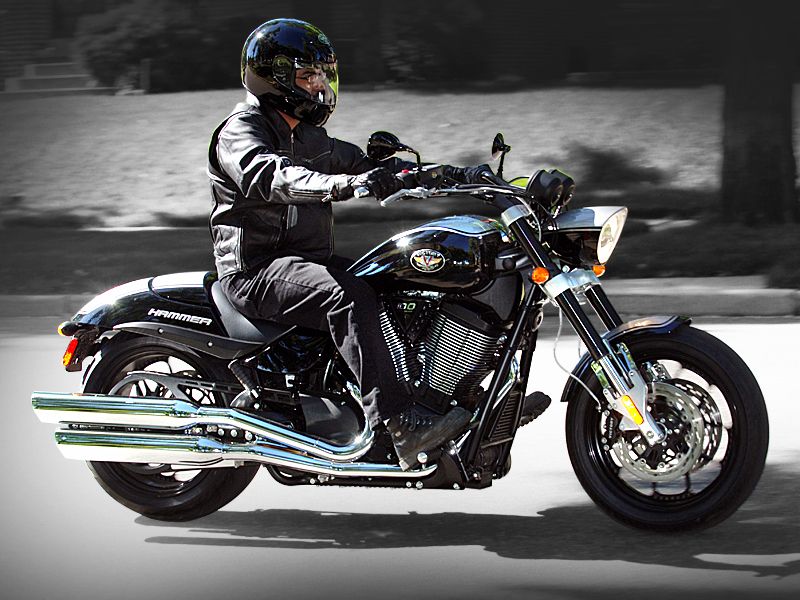 The Victory Hammer S comes with race-inspired paint, blacked-out engine, bars, mirrors, gauges and black translucent powdered coated billet wheels from Performance Machines. It looks meaner, but if you get on top of it, there isn’t much difference.
The Victory Hammer S comes with race-inspired paint, blacked-out engine, bars, mirrors, gauges and black translucent powdered coated billet wheels from Performance Machines. It looks meaner, but if you get on top of it, there isn’t much difference.
------
Test Drive
When the Hammer was first introduced, riders complained about the bike’s tendency to straighten out early in a corner and this required a little bit of effort to compensate, making the first models not so appreciated when it came to handling. So when I found my way on the 2008 model year this is what I first wanted to see. The sinuous back roads on which I started riding were perfect and if the Hammer was to make a good impression, this was the perfect time. I must say that this claimed power cruiser now features very responsive steering and leaning it seems the easiest thing. You can easy scrap the pegs on the asphalt and your ride will become a great experience.
After 10 miles of leaning, accelerating, then braking and yet again leaning, I was feeling like a new born so I have to give the needed credit to the ergonomics of this bike. The V-shaped bars are at quick reach, the seat is low and the pegs are damn relaxing. I also spent some time on the Hammer S and there things are even better. Handlebars are pulled back even more and despite the sporty impression that it gives, it is actually more relaxing and better for the log haul than the simple Hammer.
The engine is the same on both machines, a powerful 100 cubic inch V-Twin SOHC with four valves per cylinder. This is practically the unit that has all to do with the performance cruiser character as the awesome torque will have the bike amaze everyone when it comes to fast take offs. Mid-range is also strong and during my enthusiastic pass through the twisty portions combined with straight lines I noticed that this V-twin starts vibrating at around 4000 RPM, but it won’t bother at that level, it will only become noticeable. When pushing it up to 120 mph you simply don’t know what to hate more, the wind or the vibrations, but would it feel like a V-twin if it wouldn’t vibrate?
A six-gear overdrive transmission is there to help you rush the vibes away. I found the gearbox smooth and easy to use, while the clonk heard when shifting first was not out of the ordinary. Such massive, torque-producing engines seem like they never require a higher gear, but in the past years we’ve learned that a sporty character can be implemented to virtually any kind of engine so that’s why we’re shifting a sixth gears.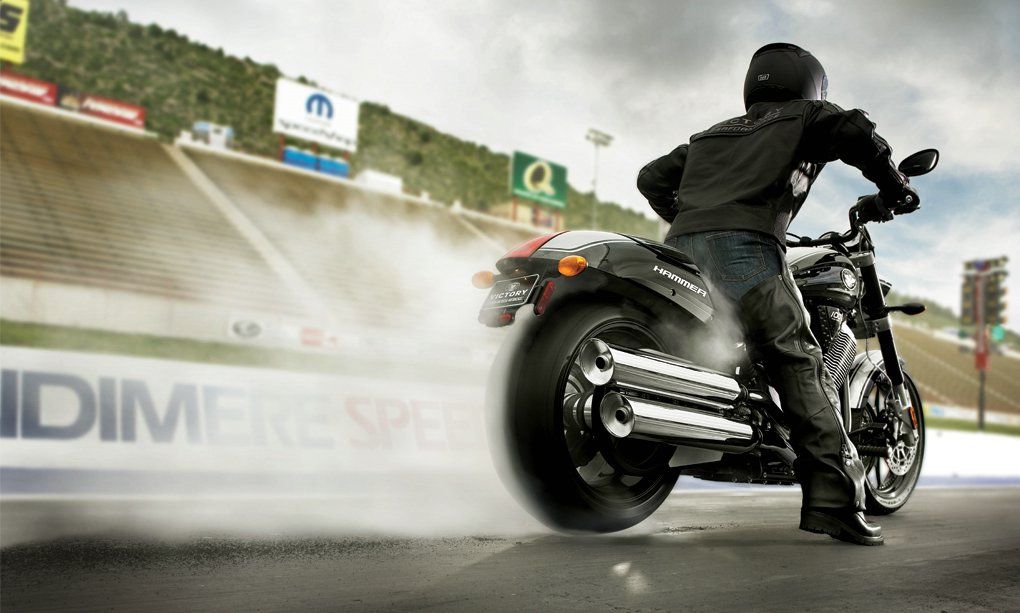 Generally, the bike performs as expected and stays well glued to the road as it has a low center of gravity and very efficient suspension equipment. It will soak up the bumps with great efficiency and leave you with a stress-free lower back at the end of the day, no matter where your ride has taken you.
Generally, the bike performs as expected and stays well glued to the road as it has a low center of gravity and very efficient suspension equipment. It will soak up the bumps with great efficiency and leave you with a stress-free lower back at the end of the day, no matter where your ride has taken you.
Putting the bike to a complete stop is easily done with the help of 300mm discs trio, two up front and one at the rear. Pulling the brake lever strongly will action the front 4-piston caliper and feel the bike barring in the asphalt. At the rear the 2-piston caliper will also brake powerfully and leave no doubts on the fact that the Victory Hammer and Hammer S are top notch machines.
Price
MSRP for the simple Hummer is $16,999 while the Hammer S has a minimum price of $19,866. The first situates just close to the Harley-Davidson V-Rod ($16,695-cheapest version), but the S model is clearly not so competitive compared to the Night Rod Special which doesn’t require a cent more than the V-Rod.
Conclusion
Victory motorcycles have always been addressed to mature riders who have a great appreciation for reliability and performance, but with the Hammer this manufacturer addresses to the younger segment which transits from sports bikes to cruisers and feel like riding a bike that incorporates features of both categories. This means creating a veritable American muscle cruiser.
------
SPECIFICATIONS
Engine and Transmission
Engine Type: 4-stroke 50° V-Twin
Cooling System: Air/Oil
Displacement: 100 ci/1634cc
Bore x Stroke: 101x102mm
Compression Ratio: 8.7:1
Valve Train: Single overhead camshafts with 4 valves per cylinder, self-adjusting cam chains, hydraulic lifters
Fuel System: Electronic Fuel Injection with 45mm throttle bodies
Fuel Capacity: 4.5/17.0 U.S. gallons/liters
Exhaust: Staggered slash-cut dual exhaust with crossover
Oil Capacity: 5.0qts/4.75ltr
Charging System: 38 amps max output
Battery: 12 volts/18 amp hours
Primary Drive: Gear drive with torque compensator
Clutch: Wet, multi-plate
Transmission: 6-speed overdrive constant mesh
Final Drive: Carbon Fiber Reinforced Belt
Chassis and Dimensions
Front Suspension: Inverted cartridge telescopic fork, 43mm diameter, 5.1in/130mm travel
Rear Suspension: Single, mono-tube gas, cast aluminum with rising rate linkage , 3.0in/75mm (3.9in/100mm on the Hammer S) travel, preload adjustable spring
Front Brake: Dual 300mm floating rotor with 4-piston caliper
Rear Brake: 300mm floating rotor with 2-piston caliper
Front Wheel: 18x3.0in
Rear Wheel: 18x8.5in
Front Tire: 130/70R18 Dunlop Elite 3
Rear Tire: 250/40R18 Dunlop Elite
Length: 93.1/2366 in/mm
Wheelbase: 65.7/1669 in/mm
Seat Height: 26.5/673 in/mm
Ground Clearance: 5.8/148 in/mm
Rake/Trail: 32.7°/5.5/140 in/mm
Dry Weight: 680/308 lbs/kg; 673/305 lbs/kg – Hammer S
GVWR: 1173/532 lbs/kg

